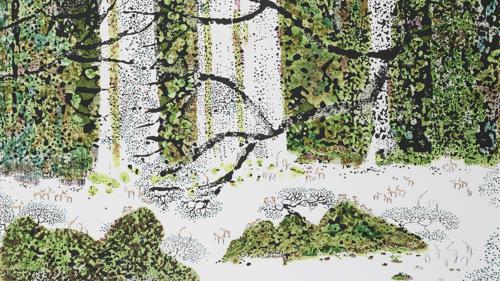陳其寬(1921-2007)以建築師為本業,從事水墨創作逾五十年,在各自領域皆扮演著舉足輕重的領先地位,其建築作品橫跨全球,其中的設計與空間布局思維,皆源自於東方哲學思想與水墨意境的再現,並結合包浩斯主義中所追求的極簡、實用且融合在地元素的精神,形成獨特的時代風格。
文字來源 :臺南市美術館
圖像來源 :陳其寬文教基金會
Chen Chi-Kwan (1921-2007) was a renowned architect by trade but engaged in ink painting for over fifty years. He played a significant role in both fields, achieving leadership status globally. His architectural works, spanning across continents, drew heavily from Eastern philosophical ideas and the aesthetics of ink painting. These influences merged with the minimalist, functional, and locally-integrated spirit of Bauhaus, culminating in a distinctive style that defined his era.
Source: Tainan Art Museum
image: Chen Chi Kwan Education and Culture Foundation

老子在《道德經》中曾言:「上善若水,水善利萬物而不爭。」這一哲理貫穿了陳其寬一生,他的內心始終是平和且與世無爭的。在〈和平共存〉一作中,飛鳥、猿猴與鹿群在瀑布和叢林間自由嬉戲、覓食,整體畫面以草綠的山野、湛藍的天空和點狀的筆墨構成,展現出優雅祥和的氛圍,不僅體現了陳其寬開闊的心境,也彰顯了他對自然的深厚情誼。
文字來源 :蕭楷競
圖像來源 :陳其寬文教基金會
According to the Tao Te Ching, Laozi once said: “the greatest virtue has the characteristic of water - where benefit flows to many but takes no credit for the good that is done.” This philosophy deeply influenced Chen Chi-Kwan, who embodied serenity and non-confrontation. In his work “Peaceful Coexistence,” birds, monkeys, and deer frolic and forage freely among waterfalls and forests. The scene features lush green grassy hills, a deep blue sky, and pointillistic brushwork, evoking a scene of graceful tranquility. This reflects Chen Chi-Kwan’s magnanimous spirit and profound connection to nature.
Source: Hsiao kai-Ching
Image: Chen Chi Kwan Education and Culture Foundation
